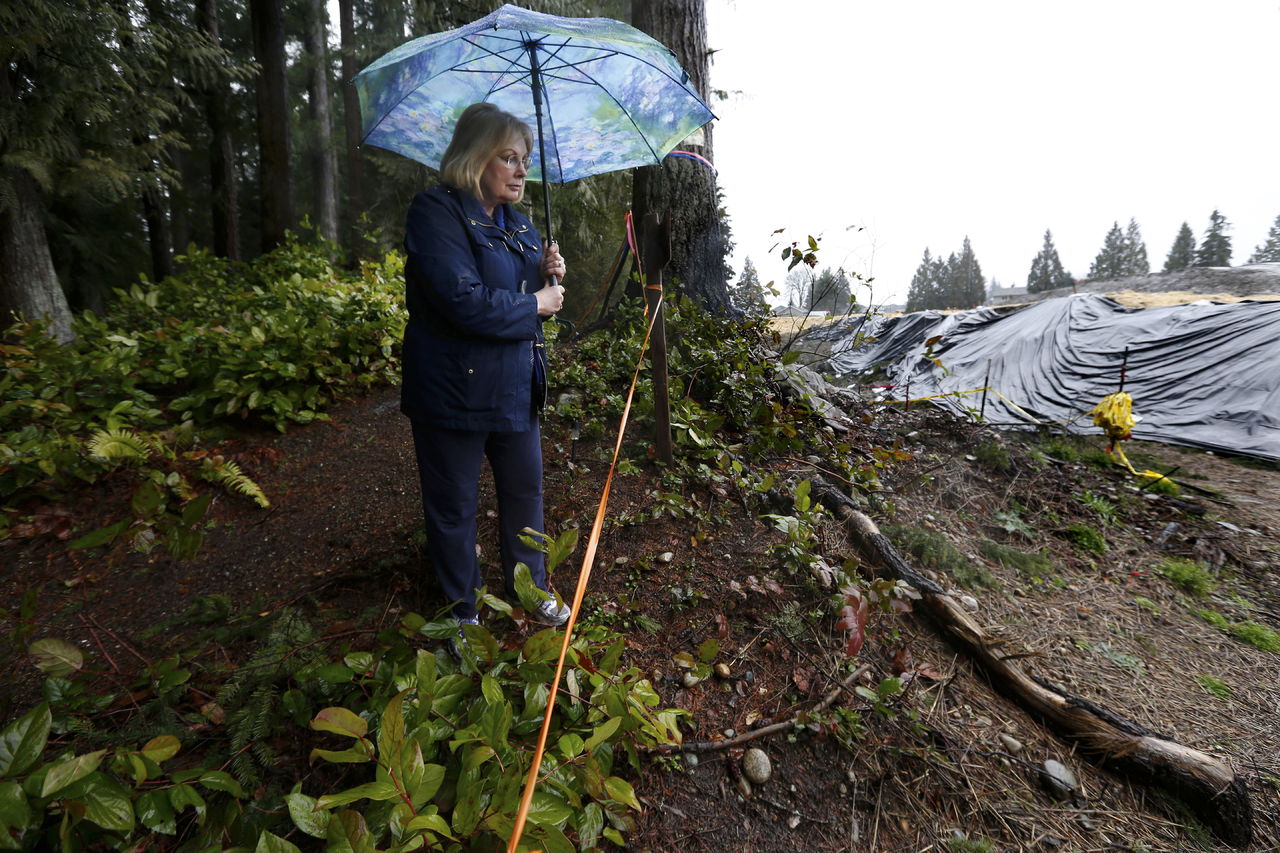LYNNWOOD — Roberta and Joseph Johnson hated to see the forested land next door erased to make way for a new subdivision, but they can accept the realities of living in a growing area.
What worried them was the health of trees on their wooded property outside of Lynnwood city limits. They point to the root system of a towering Douglas fir straddling the property line that was damaged last year during grading for 89 new homes in the Silver Peak subdivision. The more than 120-foot-tall tree, they fear, sustained lethal damage and now poses a threat of falling on the homes of current and future neighbors.
There is still a thin buffer of trees along the property line where work hasn’t occurred, but the Johnsons worry about the trees on their side, too.
“We’re trying to get them to keep at least 15 feet from the roots of our trees,” Roberta Johnson said. “So far, there’s no indication that that’s going to happen.”
Retired teachers, the Johnsons live in a home they had built in the early 1970s near Swamp Creek and I-5.
Despite all the development nearby, their immediate neighborhood near Butternut Road and Larch Way is just now starting to be transformed.
It’s an increasingly common scenario as homebuilders fill in less densely populated pockets of suburbia, meeting the demand from the 10,000 or more people expected to be added to the county’s population yearly over the next two decades.
That’s something the Johnsons are discovering in the remnants of the forest in the unincorporated enclave near Lynnwood.
“We feel that we’re representative of a lot of Snohomish County,” Roberta Johnson said. “All of the homes around us have significant trees.”
They want the county to do more to protect trees in areas like theirs.
They cite the planning director’s statutory power to intervene during potentially hazardous situations.
There’s little in county code, though, to protect tree roots that extend onto a neighbor’s property.
County code generally prohibits grading within two feet of a property line. That’s the rule even when there are trees, unless the roots are needed to stabilize a steep slope or to protect some other critical area.
Viewed from the other side of the fence, there’s no duty to limit the full use of your property to protect someone else’s tree roots.
County attorneys have characterized the Johnsons’ situation as a civil dispute.
Hearing Examiner Peter Camp noted some of the Johnsons’ concerns about trees when he approved Silver Peak a year ago. Camp ordered the developer to submit an arborist’s report and follow its recommendation to protect trees bordering the Johnson property.
An arborist the Johnsons hired said the plan proposed by the developer’s arborist of using aeration tubes to sustain tree roots in areas impacted by grading wouldn’t work because the roots were damaged already.
The Johnsons appealed unsuccessfully.
Developers and neighbors often work together to address trees near a property line, said Tom Rowe, a division manager in the county planning department.
“This isn’t a new issue for us,” Rowe said. “In Silver Peak, we’ve had more tree issues than we typically see in a development.”
In Silver Peak, trees cover most of the property line.
The outlines of the future neighborhood are taking shape there. A paved road extends from Larch Way through the 15-acre property. Crews have contoured the bare earth for home lots. Caution tape creates a buffer between the west side of the site and the Johnsons’ yard — for now.
Representatives from developer Pacific Ridge Homes did not return calls for comment. The Bothell company was bought last year by D.R. Horton, a Fort Worth, Texas-headquartered company. It claims to be America’s largest homebuilder.
The Johnsons hired Woodinville-based arborist Anthony Moran to help make their case. Moran, who specializes in construction impacts, said grading activity last year caused damage that will destroy a tree on the boundary between the Johnsons’ yard and the new development.
“If you remove half the root system, you have crippled the tree,” he said. “Then you get failure.”
Health problems for trees often lag five to 10 years behind the damage, he said.
He recommended a 25-foot buffer along the property line — 10 feet wider than the Johnsons are seeking.
Moran said other local jurisdictions he’s worked in, including Lynnwood, are stricter than Snohomish County in requiring developers to survey neighboring trees.
“There needs to be some kind of accounting for the impact we’re having on neighboring trees, especially full-grown forest trees,” he said. “There’s nothing in there that says, ‘You killed the tree and you’re responsible.’ The law doesn’t address the situation.”
In 2014, the county updated its rules for tree retention during development. That created a shift in focus to maintain canopy cover, rather than protect individual trees. During those changes, the council removed a provision requiring landscaping plans to “include a description and approximate location of any trees on adjoining properties that may be directly affected by any proposed activities.”
The Johnsons hope their future neighbors can safely enjoy the trees around them, as they have for more than four decades.
“There are negatives about the trees,” said Joseph Johnson, after pointing out piles of evergreen branches blown down by recent storms. “But the positives outweigh them.”
Noah Haglund: 425-339-3465; nhaglund@heraldnet.com. Twitter: @NWhaglund.
Talk to us
> Give us your news tips.
> Send us a letter to the editor.
> More Herald contact information.
























